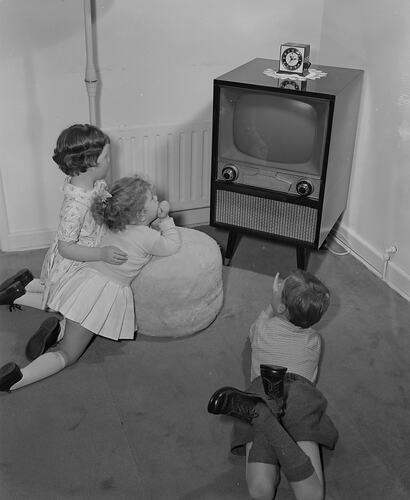Summary
Black and white 5" x 4" negative showing three young children watching a floor console television set in their lounge room in Eaglemont, 20 August 1959. This was one of the earliest TV models to be introduced: the photograph was taken just two years after the first television broadcast took place in Melbourne.
This image is part of the Laurie Richards Collection at Museum Victoria comprising approximately 85,000 negatives taken by the Melbourne based Laurie Richards Studio between the 1950s -1970s. These negatives are all mostly large format [5"x 4"/ 12.5 x 10 cm], black and white images, though a significant number are in colour. The many photographic jobs that were undertaken in the course of thirty years are itemised in a set of log books, copies of which are also held by Museum Victoria.
Laurie Richards was a professional photographer who began his career as a photo-journalist, working for the Advertiser newspaper in Adelaide, and the Argus and the Herald newspapers in Melbourne. In 1953, he opened his own business and set up a photographic studio at his home at 4 Tower Avenue, Alphington, an inner suburb of Melbourne. At its peak, in the late 1960s, the Laurie Richards Studio was one of Melbourne's pre-eminent commercial photographic studios, employing twelve photographers. The Laurie Richards Studio worked mainly in advertising and public relations, and had a broad clientele which included commercial companies, government institutions and the entertainment industry.
Description of Content
Three young children watching a floor console television set in their lounge room in Eaglemont.
Physical Description
Black and white 5" x 4" photographic negative
Significance
Because of the breadth of both the subject matter photographed and the diverse businesses which commissioned the work, and the excellent documentation that accompanies the collection, the Laurie Richards Collection at Museum Victoria is an invaluable record of Melbourne's commercial and industrial past and as such gives an insight into the social history of that period.
More Information
-
Collection Names
-
Collecting Areas
Home & Community, Information & Communication, Images & Image Making, Science & Measurement
-
Acquisition Information
Purchase
-
Place & Date Depicted
Eaglemont, Greater Melbourne, Victoria, Australia, 20 Aug 1959
-
Photographer
Laurie Richards Studio, 4 Tower Avenue, Alphington, Greater Melbourne, Victoria, Australia, 20 Aug 1959
-
Format
Negative, 5" x 4", Black & White
-
Classification
-
Category
-
Discipline
-
Type of item
-
Image Dimensions - Negative/s
103 mm (Width), 100 mm (Height)
Approximate dimensions
-
Keywords
Chairs, Clocks, Furnishings, Heaters, Houses, Lamps, Lighting, Stools, Television Receivers, Horology


